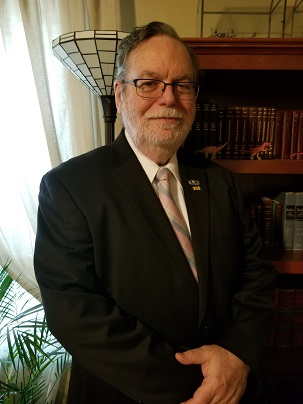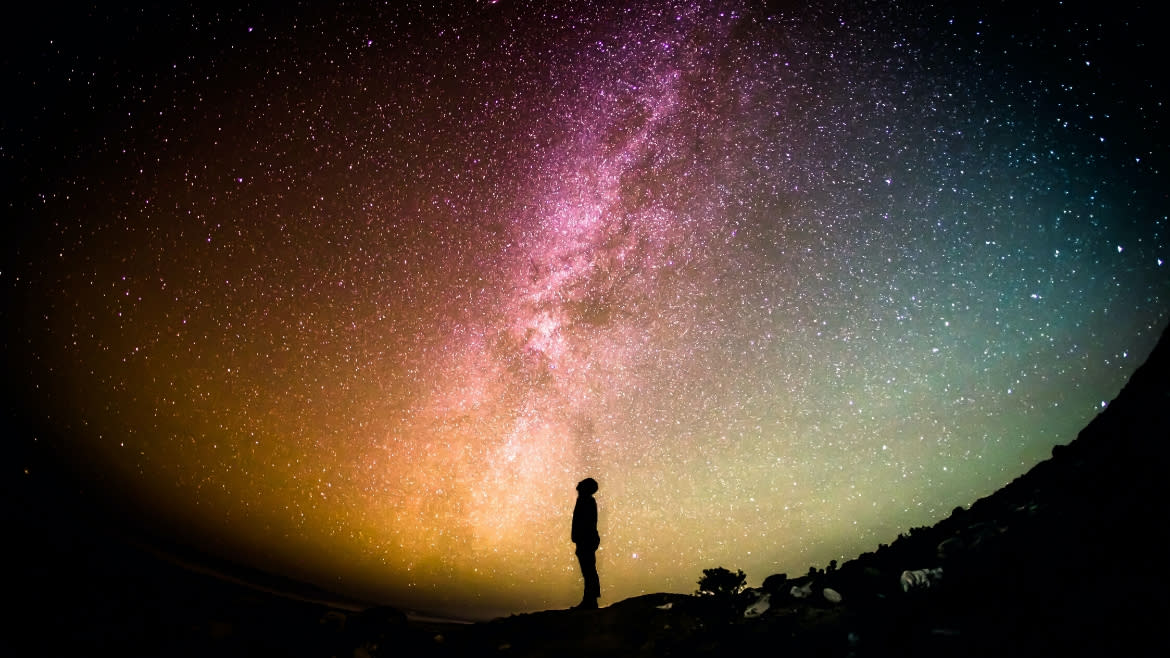
Stephen
Terry, Director

What Happened?
Commentary
for the April 3, 2021 Sabbath School Lesson
 "In the beginning God created
the heavens and the earth." Genesis 1:1, NIV
"In the beginning God created
the heavens and the earth." Genesis 1:1, NIV
Perhaps few things
generate more controversy among religionists than the story of how the Earth
and mankind came to be. The language of the Creation account in the first
chapter of Genesis has, at times, been less than helpful in bringing about a
unified understanding. The metered structure argues strongly that its writer's
intent was less to convey scientific truth than to present a heroic
mythological basis for mankind's origin, fall, and ultimate redemption through
the lives of the patriarchal heroes of Genesis. These heroes, though often
taken advantage of, rise like true heroes to overcome the adversities and
ill-intentioned individuals who challenge them. But these demi-godlike
patriarchs are merely foundations for the ultimate messianic figure introduced
in the next volume of the Pentateuch, Moses, who leads the people to redemption
and deliverance from slavery in Egypt. It is a powerful story that resonated
with those enslaved for centuries around the world, including the racial
slavery here in the United States. The biblical story still resonates as the
struggle for equality and equity between races continues to the present moment.
One of the key
elements of that struggle is the idea that all of mankind is God-breathed into
existence, making us one with the universe brought into being by the same
Creator. We are star stuff, created from the same matter found universally
throughout that creation. Perhaps this is why, when we stand beneath the night sky
and gaze upward into the expanse of the Milky Way, something moves within our
hearts. Like calls to like as the matter of the universe calls to the matter
within our being. All that matter, in turn, calls out to something beyond it
all, yearning for the touch of the Creator. We know instinctively, we are not
alone. Though the tools at our disposal can barely scratch at the surface of
infinity, we know it is there. We cannot even form a vision of infinity within
our minds. It is too vast to be contained in such images. The arrowhead on the
number line and the figure eight on its side are simply symbolic placeholders
for what we cannot see. Those crude symbols are not the reality of infinity,
and they do not prove the existence of infinity. They are simply recognitions,
by faith, that there is no end to what exists. Underived life is eternal and is
the source for all derivative life. The implied purpose then of what is
derivative is to aspire to be in union with the underived, the creative source.
Some, despite
accepting the idea of infinity based on faith and symbols, find it hard to
accept the idea of undefinable, yet intelligent, creative power capable of
bringing the universe, or even individual worlds, into existence. But even
those who stumble at that idea are still often moved by the poetic power, the
heroic flow, of Genesis, chapter 1. The introduction is so expansive as to be
scientifically imprecise to the point of demanding faith as a response, a
veritable take-it-or-leave it challenge. What does "In the beginning" even
mean? On a most basic level it means that there was a beginning. However, we
are so used to limited, linear thought that our natural response might be to
ask, "But what was before that?" Even scientists ask that about their own Big Bang
Theory. Because we do not have the tools to free ourselves from the linear time
that dominates our dimension, we cannot conceive of something like an eternal
beginning that may always be beginning and never ending. But we have had
glimpses of the possibility with the story of Schrodinger's hapless cat and its
allegorical attempt to show that it is possible for something to exist in two
states even though we can only see it in one. Even C. S. Lewis may have
unintentionally touched on the same idea when he wrote in "The Lion, The Witch,
and the Wardrobe" of it being "always winter, but never Christmas." The
existence of such a conundrum implies that in an alternate state there is
winter with Christmas. Although he used the linear concept of different dimensions
that allowed a transition from one to the other where the two different states
existed separately, he nonetheless opened the door to the possibility that the
line of demarcation between the two was only an illusion that appeared to be a
simple wardrobe but was not.
This being the case,
Genesis, chapter 1, may be an attempt to force the unintelligible into a
perspective discernable to our linear way of thinking. We may even be able to
perceive that it was a message directed specifically to us in that it is
presented as a double spiral of poetry of ascents, the two strands twisting
around each other as they ascend from simple to complex, mirroring, to a
degree, the double helix of our own DNA. First, we have Day One with the
creation of light. Opposite that is Day Four, the creation of the light
sources, the Sun, Moon, and stars. Moving up to the next step on the ladder, we
have Day Two with the creation of the sky, separating water below from water
above. This was foundational for Day Five and the creation of the birds and the
sea creatures, allowing us to climb to the next rung. Day Three brings the dry
land into existence, making possible Day Six and the appearance of plants and
the many species of land animals. The crowning achievement of that creative
ascension is the creation of mankind in a god-like capacity, reigning over the
rest of creation spread out below on that double helix. Each creature on that
helix having elements of the same DNA existing within mankind, reflecting, in
part, some of the image of mankind, which, in turn, reflects the image of the
Creator.
While this simple
poetic attempt to pass on important perspectives to mankind may be intended to
reveal elements of truth normally beyond our comprehension, within its
simplicity, we can find profundities that speak to our own survival in the here
and now. The Bible, of course, speaks of ultimate redemption and a denouement
re-creation of the Earth as an Edenic paradise. The creation account also
reveals how much of our very existence relies on an understanding of how
hard-wired we all are into Creation. Biologists have scratched the surface of
that with the development of models of food chains and food webs, but without
the foundational elements developed in the Creation poetry, they can fall short
of fully understanding the implications of it all. Perhaps the most basic truth
contained in the chapter is that destroying any part of Creation, either
intentionally or through neglect, is pointing the gun of extinction at our own
heads. Unfortunately, too many have evolved only to ask if something will
increase our wealth and power rather than, "Will it kill us?"
We have filled every
rung of Creation with macro and micro plastics and chemicals that degrade every
food chain or food web we care to model. Created to exercise dominion over the
Earth as vicegerents of God, we have chosen to be regents instead, only
concerned with our own will and never considering the faithfulness of our
stewardship over its inhabitants and resources. We have somehow become unable
to discern what is in the best interests of all in the domain we have been
gifted. If the Creation poetry of chapter one is symbolic of the DNA which
connects all of Creation, then the serpent of chapter three may be
allegorically a viral infection that attacks the genetic structure of our cells
and forces them to produce replicant genetic material that will reproduce the
sickness instead of the health we were created to "multiply" throughout
Creation. The image of the Creator, reproduced in our DNA became defiled and
instead of passing on that image like faithful vicegerents, we passed on the
distortion, and the entire world has been poisoned by it. Like slave computers,
serving a hacker and generating viral content across the World Wide Web,
Creation has become a slave-like host to the genetic aberration we willingly
absorbed as the price of a momentary narcissism. We opened that Pandora's Box,
and because we are also infected, we seem powerless to stop the process.[i]
Because the infection
is so widespread, intervention is the only reliable means to eradicate it. The
Creator offers that intervention to those who are open to change.[ii] He will remove the infected
DNA and replace it with a pure strand. But a quirk of the virus is that it
causes us to believe that intervention is not necessary, so many refuse the
cure. This response was predicted all the way back in the time of Moses, well
before the virus became as pervasive as it is today. When the people began to
die from snakebites (perhaps an allegory, referring to Genesis, chapter three),
Moses erected a symbolic serpent of bronze. The bronze may have allegorically
represented a pure strain as opposed to the poisoned one. Metal could not be
infected. All the people needed to do to survive was to accept the pure and
receive its symbolism, but many would not and perished in their unbelief.[iii]
Faced with the
allegorical intent of the heroic poetry of the Creation Story, we may respond
by ignoring it or decrying its importance and find ourselves living out the
reality of chapter three and the ultimate impact of that choice with the hero
story of Noah and the Ark. Allegorically this portrays the ultimate result of
ignoring or denying the infection, and with the starkness of the number saved
from destruction, it also illustrates the lengths the deniers will go to in
preventing action by the rest, action
that would forestall the inevitable, until it becomes an unstoppable,
cascading juggernaut of destruction and ultimate extinction.[iv] But also within that dire
prediction is an element of hope for some. A remnant[v] who can see their own illness
and the dire direction of the road we are traveling will be saved. The question
is, "Will you and I be among them?"